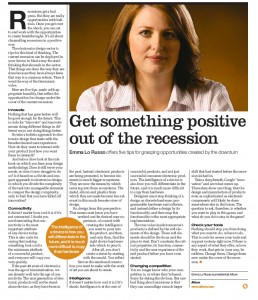Written by Emma Lo Russo and as published in the July 2009 “Australian Businesswomen’s Network” newsletter:
Leading your business to success
 You have the title, a team that reports to you and a defined business purpose and responsibility. The business environment and competition is tough and you are looking at new ways to ensure continued growth and success. You spend night and day wondering what else you can do, what extra advantage you can create…
You have the title, a team that reports to you and a defined business purpose and responsibility. The business environment and competition is tough and you are looking at new ways to ensure continued growth and success. You spend night and day wondering what else you can do, what extra advantage you can create…
It is likely you already hold that advantage. And the answer is your own employees. You can easily move from managing them to do their job (even if you do this aspect very well), to leading them to achieve something far greater – for themselves and for your business.
Understanding the difference between management and leadership
Management is about getting the best out of resources, mostly through defining responsibilities and processes, to further the goals of the company. ‘Leadership’ on the other hand is painting a common view of the future and inspiring and galvanising your team towards achieving it.
There are some key leadership characteristics and qualities to embody if you hope to achieve a powerful business advantage through your people. A key aspect is understanding that your people are entirely your business. They provide the moment of truth every time they interact with your customers, partners, suppliers, each other etc. It is important that they share and believe in the aspirations for your company. That they can see how to align their communications and activities they do every day to the greater picture you have of success, and how that can in turn help them enjoy and benefit from that success.
Acknowledging, encouraging, empowering your people to act in harmony with your vision and values is far more powerful than prescribing what you want and outlining precisely how they should be doing it.
Empowering your people
Regularly sharing your vision and plans for the future and encouraging your team to help visualise success will help stimulate growth. Looking to your people to help identify the best growth opportunities and providing regular forums for your employees to present their ideas can help grow your business. Acknowledge all good ideas, empower your people to own those ideas and reward them when they help you get to where you want to go faster. The more you can celebrate success with your employees, the greater the performance culture you are creating.
Tips to help you lead your organisation to success:
- Paint a common view of the future and translate your vision and strategy into workable goals for your employees
- Share your vision regularly, applying short and long-term frame of references for all projects and activities
- Live and promote your desired culture and values
- Model integrity in decisions, communication and treatment of people – always lead by example
- Recognise others’ strengths and limitations – focus on building teams around individual employees'(and your own) strengths
- Coach, mentor and develop your team – help your team members develop self-awareness and strive for personal development, helping them align their career aspirations with your business goals
- Inspire, encourage and acknowledge action and commitment from your employees
When thinking about leadership, it is good to reflect on the line “follow me, I am right behind you”.
If you lead through inspiration, suggestion and example then your team will follow, encourage others and deliver you greater success.
To read the article in context and others on leadership go to:
To follow Emma on Twitter: www.twitter.com/EmmaLoRusso







